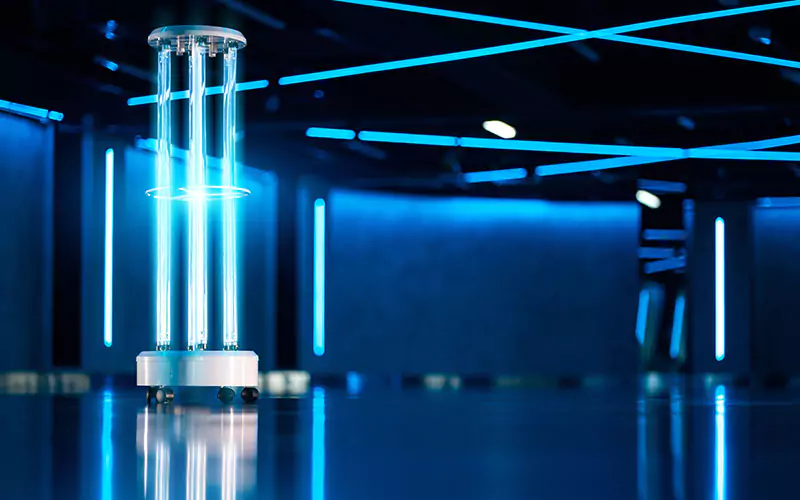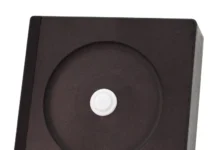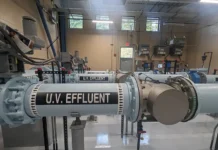Kari Sholtes, Ph.D., instructor, CMU/CU Boulder Civil Engineering, Colorado Mesa University
Richard Simons, Ph.D., head of application science, AquiSense Technologies
Sara E. Beck, Ph.D., assistant professor, University of British Columbia
Babak Adeli, Ph.D., director of R&D, Acuva Technologies Inc.
Zhe Sun, Ph.D., post-doc, Research Center for Eco- Environmental Sciences, Chinese Academy of Sciences
Ultraviolet (UV) light is commonly used for disinfection. It inactivates microorganisms (including viruses) by degrading their genetic material and structural molecules so that they are no longer infectious. UV light is commonly used for disinfecting water, air and surfaces; however, the wavelengths that are most effective at inactivating microbes also are considered damaging to human skin and eyes. This article gives an overview, for general audiences, of UV disinfection.
What is UV light?
Light can be described as both a particle and a wave, a phenomenon known as wave-particle duality. As a particle, massless photons carry light energy throughout the universe (at the speed of light). As a wave, the energy is radiated by smooth oscillations of the electromagnetic field. UV radiation is on the short-wavelength side of the electromagnetic spectrum, occupying the range from 100 to 400 nm. The UV range is further subdivided into four categories: UV-A (315 nm to 400 nm), UV-B (280 nm to 315 nm), UV-C (200 nm to 280 nm) and vacuum UV (100 to 200 nm).
Vacuum UV wavelengths are so-named because of their strong absorption, even by air. UV-A wavelengths, which cause suntans and are used in tanning salons (Nilsen et al. 2016), also are commonly used for curing anything from inks or coatings to adhesives and nail polish (Endruweit 2006). The energy carried by light is inversely proportional to its wavelength; therefore, the shorter the wavelength, the higher the energy. For this reason, UV-B radiation, at shorter wavelengths than UV-A, has higher energy and carries a greater cancer risk in humans (NTP, 2016). Even higher-energy radiation in the UV-C band is most commonly used for disinfection. The majority of microbes show a relative peak in sensitivity to radiation around 265 nm, and so the application of UV disinfection has targeted the “germicidal” range around this peak.
Sources of UV light
As with other types of light on the electromagnetic spectrum, UV light is produced both naturally and artificially. Natural UV light comes from the sun; some of which reaches the Earth’s surface, and some is absorbed by the atmosphere. Due to strong absorption of higher-energy radiation in the upper atmosphere almost no solar UV-C reaches the Earth’s surface (ASTM G-173 2020); the spectrum of solar radiation – commonly referred to by air mass (AM) values – varies across the Earth’s surface.
Artificial UV light is produced primarily from plasma discharge lamps and light-emitting diodes (LEDs), as well as unintentional emissions from activities such as arc welding. Plasma discharge lamps contain a gas mixture enclosed inside a glass tube. As a voltage is applied to the lamp filament, electrons within the enclosed gas are excited to a higher energy state; as they fall back to the ground state, they release that extra energy as a photon, which is a packet of light energy. The spectrum, or wavelengths emitted, depends on the elements of the gas inside. Common plasma discharge lamps include mercury vapor lamps, metal halide lamps, xenon lamps (pulsed UV), excimer and exciplex lamps, and deuterium lamps.
Ultraviolet light emitting diodes (UV LEDs) are solid state semiconductor devices. With an applied voltage, electrons are pushed across an energy barrier (band gap) separating differently charged layers within the LED crystal structure. Once across the barrier, these electrons can lose the energy gained in the transition and emit a photon. The choice of semiconducting materials used in the LED dictates the size of the barrier and therefore the wavelength of the photon emitted. Commercial UV LEDs are formed of thin crystalline aluminum gallium nitride (AlGaN) layers deposited onto a substrate (sapphire or aluminum nitride); the ratio of aluminum to gallium in the thin layers determines the band gap and so the emission spectrum emitted by the LED.
How does UV light inactivate microorganisms?
UV-C and UV-B light has a direct disinfection effect when its energy is absorbed by genetic material (limiting replication) or by other cellular or viral components such as a protein (limiting attachment and infectivity). UV-B and UV-C photons can directly alter chemical bonds within these key biomolecules, affecting their structure and function. Where photons are absorbed by DNA/RNA the resulting damage can inhibit the microorganism’s ability to replicate, rendering it no longer infectious (Harm 1980).
UV light can also indirectly inactivate microbes at slower rates than the direct damage caused by UV-B and UV-C wavelengths. UV-A light enables disinfection by activating naturally occurring constituents in water or target cells which generate highly reactive chemical species, such as hydroxyl radicals (Lester et al., 2013); these reactive species can cause the degradation of chemical compounds that would not be affected by direct UV photolysis. Though the rate of disinfection from these UV-A wavelengths is slower than that of direct damage by UV-B and UV-C rays, it cannot be discounted as a technology due to the abundance of free UV-A within sunlight (Besaratinia et al. 2011). Because UV-induced damage impacts each microbe and its components differently, applying various UV wavelengths to water, air, or surfaces containing multiple microbes could be considered a more effective strategy than applying UV light at only one wavelength.
For pathogenic microbes the ability to reproduce is crucial for infection or invasion; therefore, measuring microbial replication before and after treatment (inactivation) is a good way of defining system efficacy. Inactivation is defined as the decrease in concentration of culturable microbes (Nt) from the starting concentration (No) as a result of exposure to a disinfectant over a period of time (t) (Hijnen et al, 2006). A log10 value is usually used, for example, 1-log (90%), 2-log (99%), 3-log (99.9%), or 4-log (99.99%) inactivation. The use of standardized methods as described allows for definition of a reduction equivalent UV dose (RED, mJ cm-2) from a measured inactivation, which can be employed as a performance metric for UV disinfection systems.
Using UV light to disinfect fluids and surfaces
UV light can inactivate microbes in air, on surfaces (including working surfaces, food products, pharmaceuticals and packaging) and in water or other liquids. Chemical or physical (i.e., heat) disinfectants require a certain concentration and contact time or temperature to be reached to inactivate a target microbe. Similarly, the degree of UV disinfection is governed by degree of UV exposure of the target microbe. Furthermore, the wavelength of that UV radiation and the microbe itself will impact the overall inactivation.
The degree of UV exposure is expressed as a UV dose (mJ cm-2, more correctly termed “fluence”), which is the amount of UV light delivered to the target microbe. UV dose is the product of UV irradiance and exposure time, meaning that a higher UV dose could be delivered by increasing the intensity of UV light, increasing the exposure time, or both. Within real-world systems, any individual microbe will not necessarily experience the same UV dose as any other microbe during its exposure. For fluids (generally air and water), this is due to a combination of uneven delivery of UV light (irradiance) throughout the treatment volume and differences in flow paths of the fluid through the system. For surfaces, this is due to non-uniform UV exposure across the surface of interest. When looking at the overall system performance, an average log inactivation will be measured. In a separate test, using well-calibrated equipment, the irradiance and flow paths are tightly controlled, and a dose-response curve is created to show the measured log inactivation of a microbe for a set of applied UV doses. By comparing the average inactivation measured in the system to what was measured in the calibration experiment, it is possible to assign a reduction equivalent dose (RED). This is the average dose required to achieve an equivalent inactivation as measured in the system.
The RED of a UV system can be estimated by simulation but cannot be easily guessed. The generation and distribution from UV light sources is complex in nature. Propagation of light through a system requires accurate description of numerous optical interfaces and geometric features. In addition, fluids may be cloudy (turbid) and cause the light to be scattered; local fluid flow paths strongly affect residence times at different points, causing jet streams or trapping flow within vortices. Even within the relatively simpler case of surface irradiation, rough surfaces can introduce shadowing effects that must be considered. Parameters, such as humidity, also show a considerable effect on the inactivation of surface-bound microbes.
Inactivation of the same microbial species can vary from wavelength to wavelength. For example, the inactivation of adenovirus, a common cold virus, is 16 times greater at 210 nm than at 254 nm (Beck et al. 2014). Equivalent systems may impart dramatically different inactivation effects depending on the target microbes being exposed. The susceptibility of microbes to UV radiation differs significantly (Beck et al., 2015). For example, parasitic worm eggs are highly resistant to UV light, whereas protozoa such as Giardia and Cryptosporidium are highly sensitive (Hijnen et al, 2006). The most sensitive virus known (Bacteriophage T4) is about 75 times more susceptible than the most resistant virus known (Infectious Pancreatic Necrosis Virus, IPNV) under UV radiation at 254 nm (Malayeri et al. 2016). Bacteria are typically highly susceptible to UV radiation, though extremophiles such as D. radiodurans can be orders of magnitude more resistant (Pogoda 2005).
The wavelength of applied germicidal light is another characteristic that must be considered. As discussed previously, different wavelengths (UV-A, UV-B, UV-C) can cause different photochemical reactions and target different cellular processes. However, even within these bands, the efficiency of these photochemical reactions varies. This variation in efficiency is described by the “germicidal action spectrum,” or spectral sensitivity, of the target microbe, and though variation is seen between microbes, a common feature is a broad peak about 265 nm, tailing to near-zero about 300 nm on the longer-wavelength side and falling to ~50% around 240 nm. Some microbes, especially viruses, show a greatly increased susceptibility to shorter UV-C wavelengths (Beck et al. 2014), leading to interest in the potential of so-called “far UV-C” disinfection (Simons et al. 2020).
Safety
As with disinfection potential, the hazard of UV radiation varies with both wavelength and exposure. The risks associated with each UV source should be considered before use; reputable manufacturers will provide guidance for
safe use.
When using germicidal UV sources, safe practices are required to protect any person who may be exposed. UV radiation is hazardous to the skin and eyes, and proper personal protective equipment (PPE) is often recommended; common symptoms of UV overexposure are sunburn-like reactions in skin (erythema) and a painful, itchy condition in the eyes (photokeratitis). Recent studies indicate that far UV-C (200 to 225 nm) may provide germicidal effects without damaging the skin or eyes; the IUVA has published a review of this technology for further reading (Simons et al. 2020).
Working safely with UV means understanding the physics of the source (wavelength, power, distance), the chemistry of the target (ozone generation, material degradation, volatile compounds) and the conditions of the exposure (PPE, time, shielding, safety interlocks). Follow institutional guidelines where appropriate, and, if in doubt, use caution to avoid unnecessary human exposure and sufficiently cover the skin and eyes. More complete discussion of UV safety considerations is provided in CIE 187:2010 (CIE, 2010), 2006/25/EC (European Parliament, 2006), and US NTP 14th Report on Carcinogens (NTP, 2016).
Contact: Kari Sholtes, [email protected]; Richard Simons, [email protected]; Sara E. Beck, [email protected]; Babak Adeli, [email protected]; Zhe Sun, [email protected]
REFERENCES
- ASTM G173-03, Standard Tables for Reference Solar Spectral Irradiances: Direct Normal and Hemispherical on 37° Tilted Surface, ASTM International, West Conshohocken, PA, 2020, www.astm.org
- Beck, S. E., Rodriguez, R. A., Linden, K. G., Hargy, T. M., Larason, T. C., & Wright, H. B. Wavelength dependent UV inactivation and DNA damage of adenovirus as measured by cell culture infectivity and long range quantitative PCR. Environ Sci Technol, 48(1), 591-598. (2014),
- Beck, S.E.; Wright, H.B.; Hargy, T.M.; Larason, T.C., Linden, K.G. Action spectra for validation of pathogen disinfection in medium-pressure ultraviolet (UV) systems. Water Res. 70, 27-37. (2015).
- Besaratinia A., Yoon J.I., Schroeder C., Bradforth S.E., Cockburn M., Pfeifer G.P. Wavelength dependence of ultraviolet radiation-induced DNA damage as determined by laser irradiation suggests that cyclobutane pyrimidine dimers are the principal DNA lesions produced by terrestrial sunlight. FASEB J 25:3079–3091 (2011).
- CIE (International Commission on Illumination) UV-C Photocarcinogenesis risks from germicidal lamps (2010) CIE 187:2010. http://files.cie.co.at/cie187-2010%20(free%20copy%20March%202020).pdf
- Endruweit A, Johnson M.S., and Long A.C. Curing of composite components by ultraviolet radiation: A review. Polymer composites 27, 119-128 (2006).
- European Parliament, Consolidated text: Directive 2006/25/EC of the European Parliament and of the Council of 5 April 2006 on the minimum health and safety requirements regarding the exposure of workers to risks arising from physical agents (artificial optical radiation) (19th Individual Directive within the meaning of Article 16(1) of Directive 89/391/EEC). http://data.europa.eu/eli/dir/2006/25/2019-07-26
- Harm W. Biological effects of ultraviolet radiation. United Kingdom: University Press (1980).
- Hijnen, W. A. M., Beerendonk, E. F. & Medema, G. J. Inactivation credit of UV radiation for viruses, bacteria and protozoan (oo)cysts in water: A review. Water Res. 40, 3–22 (2006).
- Lester Y., Sharpless C.M., Mamane H. & Linden K.G. Production of photo-oxidants by dissolved organic matter during UV water treatment. Environ Sci Technol 47, 11726–11733 (2013).
- Malayeri A.H., Mohseni M., Cairns B., Bolton J.R., Chevrefils G., Caron E., Barbeau B., Wright H. and Linden K.G. Fluence (UV dose) required to achieve incremental log inactivation of bacteria, protozoa, viruses and algae. IUVA News 18(3): 4-6 (2016).
- Nilsen L.T., Hannevik M., Veierød M.B. Ultraviolet exposure from indoor tanning devices: a systematic review. Br J Dermatol; 174(4), 730-740 (2016).
- NTP (National Toxicology Program). Report on Carcinogens, Fourteenth Edition.; Research Triangle Park, NC: U.S. Department of Health and Human Services, Public Health Service. (2016)
- https://ntp.niehs.nih.gov/ntp/roc/content/profiles/ultravioletradiationrelatedexposures.pdf
- Pogoda De La Vega U., Rettberg P., Douki T., Cadet J. & Horneck G. Sensitivity to polychromatic UV-radiation of strains of deinococcus radiodurans differing in their DNA repair capacity. International Journal of Radiation Biology, 81:8, 601-611 (2005).
- Simons R.M., Blatchley III E.R., Linden K.G. Far UV-C in the 200 – 225 nm range, and its
- potential for disinfection applications, IUVA, (2020). Accessed online 28/07/2020 https://bit.ly/2ZyIAkc





